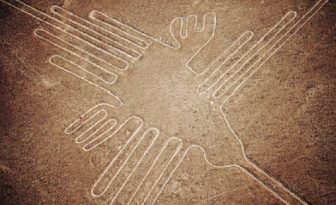Nazca culture, also known as Nasca, flourished in southern Peru during the period around A.D. 1 to A.D. 700. The Nazca culture emerged in distinct stages: Early, Middle, and Late, with a Classic period between A.D. 250 and A.D. 750, the time during which the Nazca lines were constructed. From studies of ceramic designs in the region, archaeologists assert that Nazca culture appears to have developed out of the Paracas culture before it. Additional archaeological evidence shows that after A.D. 900, the Nazca apparently fell under the Tiahuanaco culture influence until the Inca eventually conquered the entire region in the 15th century.
Nazca agricultural settlements were located in the Nazca, Pisco, and Nazca farming was possible on the desert because of the irrigation systems they constructed to bring water down from the mountains. In addition to their crops and animal husbandry, the Nazca relied on hunting and fishing. In the 1930s, aerial exploration of the desert land surrounding the Palpa Valley revealed a remarkable network of lines and trapezoids. The lines formed giant animals, flowers, plants, and human figures. Through radiocarbon dating and the resemblance of the geoglyphs to pottery designs, archaeologists were able to identify the lines as Nazcan. Anthropologists further theorize that these figures were built to be seen by giant condors, which the Nazca people believed brought the rains to their desert croplands. The lines are also thought to be related to Nazca astronomy and to collectively form a giant calendar. Some 300 figures, well preserved, cover nearly 400 square miles of the desert pampa sand, where there is little rain or wind to erode the ancient past.
 Nazca artisans excelled in their production of beautiful ceramics and textiles. Highly polished, expertly designed, and polychrome painted, the pottery of the Nazca is unlike that of any other Peruvian culture known. Nazca textiles show multitudes of weaving techniques and exemplary skills in dyeing with several shades of the same color. Archeological excavation reveals that both coastal cotton and highland alpaca wool were used in Nazca textiles. The Nazca also traded with other cultures in the region.
Nazca artisans excelled in their production of beautiful ceramics and textiles. Highly polished, expertly designed, and polychrome painted, the pottery of the Nazca is unlike that of any other Peruvian culture known. Nazca textiles show multitudes of weaving techniques and exemplary skills in dyeing with several shades of the same color. Archeological excavation reveals that both coastal cotton and highland alpaca wool were used in Nazca textiles. The Nazca also traded with other cultures in the region.
Although some theorists argue that the Nazca were a violent and warlike pre-state people, no crucial evidence has been found to support this claim. The Nazca engaged in regional warfare only to protect their territory. Long before the encroachment of Europeans, the Nazca were assimilated into other cultures. Their lives lived on, however, in local legends and lines until archeologists reconstructed their culture and its role in the development of later and larger empires. The Nazca are now understood to have contributed greatly to the development of subsequent state societies through (a) complex irrigation systems, (b) weaving technologies from cotton grown on the coast and alpaca raised in the mountains, and (c) the production of pottery for food storage and trade.
References:
- Browne, D. M. (2002). TheNascas. Oxford, UK: Basil Blackwell.
- Scarre, C. (1997). Ancient civilizations. New York: Longman.
- Silverman, H. (2002). Ancient Nasca settlement and society. Iowa City: University of Iowa Press.

